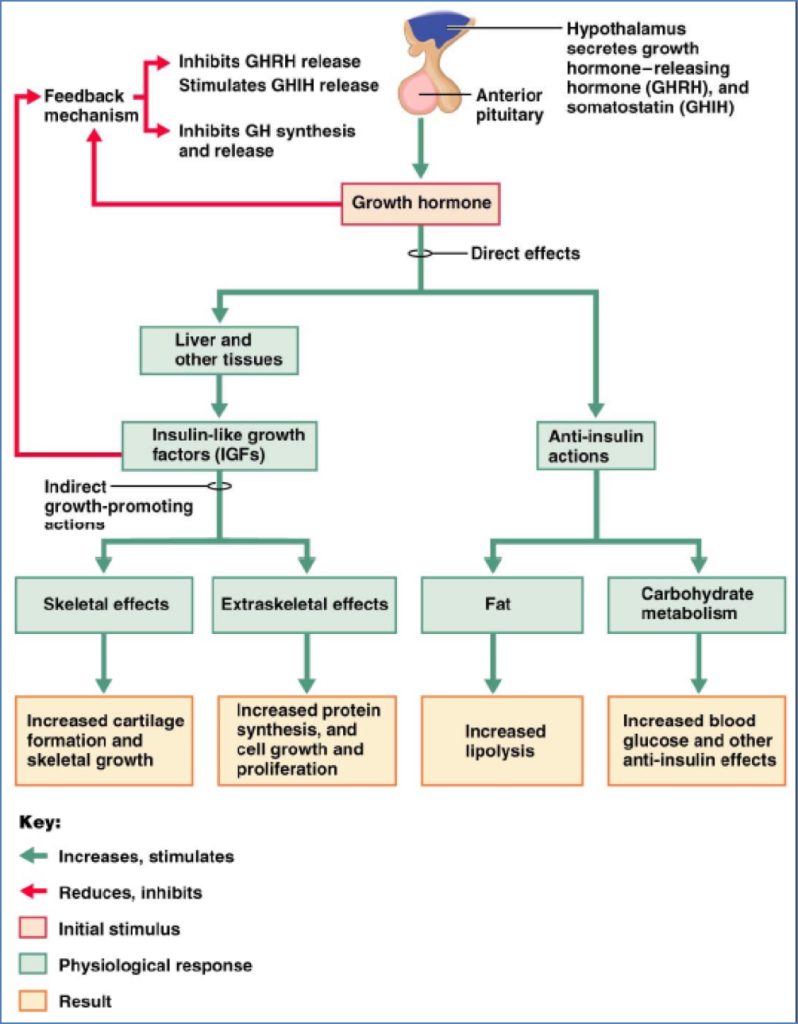Table of Contents
Overview – Endocrine Growth Regulation
Endocrine growth regulation involves complex interactions between genetic, nutritional, and hormonal factors that coordinate growth from fetal life through adulthood. Central to this process are growth hormone, insulin-like growth factors, and a range of regulatory hormones that act on multiple tissues to drive longitudinal bone growth, organ development, and metabolic adaptation.
Definition
- Endocrine growth regulation refers to hormonal control over cellular proliferation, bone elongation, organ growth, and metabolic functions during development.
- Involves growth hormone (GH), insulin-like growth factors (IGF-I, IGF-II), sex hormones, thyroid hormone, cortisol, and somatostatin.
Influences on Growth
- Genetics: Provides baseline growth potential.
- Nutrition: Critical throughout growth phases; malnutrition negatively affects growth.
- Hormonal Factors: Core regulators driving growth at different developmental stages.
Phases of Growth
| Growth Phase | Nutrition | Hormonal Contribution | Genetic Influence |
|---|---|---|---|
| Fetal (in utero) | Primary determinant | Insulin, IGF-I | Minimal |
| Infantile (birth – 2 yrs) | Primary determinant | GH and IGF low but present | Starts after first few months |
| Pre-Pubertal (childhood) | Less dominant unless malnourished | ↑ IGF levels, ↑ GH receptors | Significant |
| Pubertal (early teens) | Less dominant unless malnourished | Sex hormones ↑ GH & IGF | High |
| Post-Pubertal (late teens) | Sustained growth for trunk (~3 yrs) | GH, IGF continue | Peak influence |
Major Hormones Involved in Growth
- Growth Hormone (GH; somatotropin)
- Insulin-like Growth Factors (IGF-I, IGF-II; somatomedins)
- Somatostatin (GH inhibitor)
- Thyroid Hormone
- Cortisol (permissive role)
- Sex Hormones (oestrogen, testosterone)
Somatostatin (Primary Inhibitor of Growth)
- Secreted by: Hypothalamus, placenta, pancreas.
- Actions:
- Inhibits GH, TSH, prolactin, ACTH (pituitary).
- Inhibits insulin, glucagon, exocrine pancreas (pancreas).
- Slows gastric emptying and gut motility (GI tract).
- Stimulated by: Urocortin-3, CCK, local stimulants.
- Regulated by: Primarily local factors.
Hypothalamic Hormone of Growth
Growth-Hormone Releasing Hormone (GHRH)
- Produced by: Hypothalamus (also GIT, pancreas, placenta).
- Stimulated by: Dopamine, GABA, α-adrenergic agonists.
- Action: Activates anterior pituitary somatotropes → GH secretion.
Anterior Pituitary Hormone of Growth
Growth Hormone (GH)
- Produced by: Somatotrophs (anterior pituitary).
- Transport: ~45% bound to carrier protein (prolongs half-life).
- Regulation:
- Stimulated by: GHRH.
- Inhibited by: Somatostatin.
Actions
Growth-Promoting:
- Longitudinal bone growth.
- Skeletal muscle growth.
- Liver and organ growth.
- Stimulates IGF synthesis & IGF-binding proteins.
Metabolic:
- Lipolysis.
- Ketogenesis.
- Gluconeogenesis.
- Protein synthesis.
- Lactation.
- Insulin antagonism.
- Immune modulation.
Target Organs:
- Liver → Hepatocyte Growth Factor.
- Chondrocyte → Fibroblast Growth Factor.
- Kidney → Epidermal Growth Factor.
- Pancreas → Nerve Growth Factor Receptors.
- Thymus → IL-1 (stimulates bone marrow).
- Uterus, Breast → Oestrogen receptor upregulation.

Insulin-Like Growth Factors (IGFs)
- IGF-I: Chromosome 12.
- IGF-II: Chromosome 11.
- Produced by: Liver (postnatally); multiple fetal tissues (in utero).
- Transport: Bound to IGF-binding proteins (IGFBPs).
- Actions:
- Stimulates cell division.
- Major paracrine role during fetal life.
- Essential for intrauterine growth; IGF-I deficiency → intrauterine growth retardation.
Summary – Endocrine Growth Regulation
Endocrine growth regulation integrates hormonal, genetic, and nutritional signals across developmental stages. Growth hormone, IGFs, somatostatin, sex hormones, and thyroid hormone coordinate tissue expansion, bone growth, and metabolic adaptation. For a broader context, see our Endocrine Overview page.